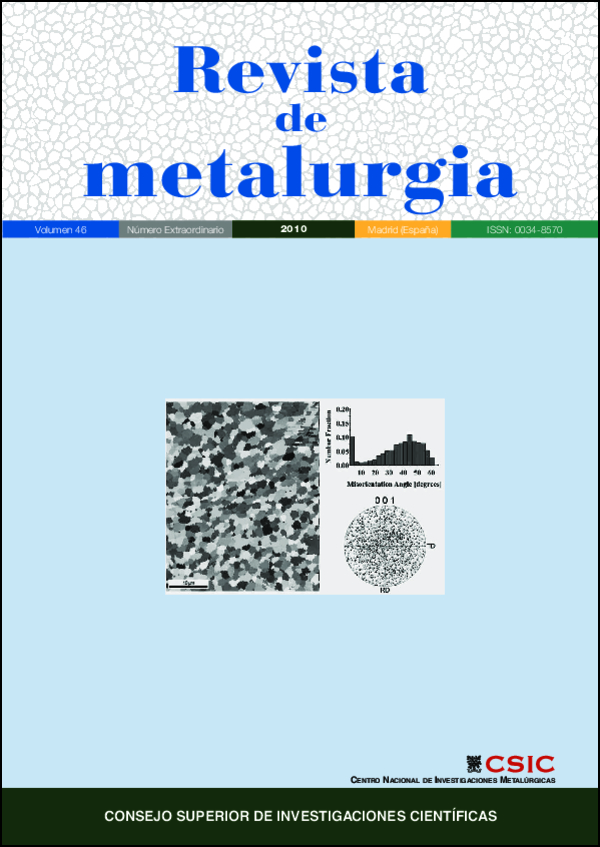Use of the Gurson-Tvergaard-Needleman (GTN) damage model to simulate small punch test on pre-cracked specimens
DOI:
https://doi.org/10.3989/revmetalmadrid.05XIIPMSKeywords:
Small punch test, Pre-cracked specimen, Gurson-Tvergaard-Needleman damage model, Damage parameters, Ductile fractureAbstract
Small Punch Test (SPT) is a feasible alternative to determine the mechanical properties in those cases where there is not enough material for conducting conventional tests. Nowadays, there is a great interest in using this test on precracked specimens (P-SPT) in order to determine the fracture properties of the material, as well. In the case of ductile material behaviour, theGurson-Tvergaard-Needleman (GTN) damagemodel can be used, based on a set of constitutive parameters, to reproduce the material behaviour up to final fracture. These constitutive parameters take into account the nucleation, growth and coalescence of microvoids as mechanisms of damage evolution in ductile materials. The aim of this paper is to develop a methodology for the identification of these constitutive parameters, based on the numerical adjustment of the experimental results obtained from the P-SPT tests.
Downloads
References
[1] J.M. Baik, J. Kameda y O. Back, Scr. Metall. Materialia 17 (1983) 1.443-1.447.
[2] X. Mao y H. Takahashi, J. Nucl. Mater. 150 (1987) 42-52. doi:10.1016/0022-3115(87)90092-4
[3] X.Mao, H. Takahashi y T. Kodaira, Mater. Sci. Eng. A I50 (1992) 231-236. doi:10.1016/0921-5093(92)90116-I
[4] T.Misawa, T. Adachi,M. Saito y Y. Hamaguchi, J. Nucl. Mater. 150 (1987) 194-202. doi:10.1016/0022-3115(87)90075-4
[5] T. Misawa, Y. Hamaguchi y M. Saito, J. Nucl. Mater. 155-157 (1988) 749-753. doi:10.1016/0022-3115(88)90409-6
[6] T. Misawa, S. Nagata, N. Aoki, J. Ishizaka y Y. Hamaguchi, J. Nucl.Mater. 169 (1989) 225-232. doi:10.1016/0022-3115(89)90538-2
[7] T.Misawa, K. Suzuki,M. Saito y Y. Hamaguchi, J. Nucl. Mater. 179-181 (1991) 421-424. doi:10.1016/0022-3115(91)90114-M
[8] T. Misawa, T. Ohtsuka, M. Seo y M. Saito, J. Nucl. Mater. 179-181 (1991) 611-614. doi:10.1016/0022-3115(91)90162-Z
[9] S.H. Chi, J.H. Hong y I.S. Kim, Scr. Metall. Materialia 30 (1994) 1.521-1.525.
[10] M.L. Saucedo-Muñoz, S.C. Liu, T. Hashida, H. Takahashi y H. Nakajima, Cryogenics 41 (2001) 713-719. doi:10.1016/S0011-2275(01)00135-7
[11] Y. Ruan, P. Spätig yM. Victoria, J. Nucl.Mater. 307-311 (2002) 236-239. doi:10.1016/S0022-3115(02)01194-7
[12] E.N. Campitelli, P. Spätig, R. Bonadé, W. Hoffelner y M. Victoria, J. Nucl.Mater. 335 (2004) 366-378. doi:10.1016/j.jnucmat.2004.07.052
[13] M.A. Contreras, C. Rodríguez, F.J. Belzunce, y C. Betegón, Fatigue Fract. Eng. Mater. Struct. 31 (2008) 727-737. doi:10.1111/j.1460-2695.2008.01259.x
[14] J. Ju, J. Jang y D. Kwon, Int. J. Press. Vessels Pip. 80 (2003) 221-228. doi:10.1016/S0308-0161(03)00131-5
[15] I.I. Cuesta, J.M. Alegre y R. Lacalle, J. A. Álvarez y F. Gutiérrez-Solana, Anal.Mec. 25 (2008) 486-491.
[16] I.I. Cuesta, J.M. Alegre y P.M. Bravo, Anal.Mec. Fract. 26 (2009) 382-387.
[17] ASTME 8M, Annual Book or ASTM Standards, Vol. 3.01, American Society for Testing and Materials, (2003).
[18] W. Ramberg y W. R. Osgood, Technical Note 902, National Advisory Committee for Aeronautics, Washington DC, EE. UU., 1943, pp. 1-13.
[19] J. Autillo, M.A. Contreras, C. Betegón, C. Rodríguez y F.J. Belzunce, Anal.Mec. Fract. 23 (2006) 77-83.
[20] J. Besson, L. Devillers-Guerville y A. Pineau, Eng. Fract. Mech. 67 (2000) 169-190. doi:10.1016/S0013-7944(00)00056-4
[21] A.L. Gurson, J. Eng.Mater. Tech. 99 (1977) 2-15. doi:10.1115/1.3443401
[22] A.L. Gurson, Proc. Int Conf. Fracture (Ed) DMR Taplin, Oxford, Inglaterra, Pergamon 2, 1977, pp. 357-364.
[23] V. Tvergaard, Adv. Appl. Mech. 27 (1990) 83-151. doi:10.1016/S0065-2156(08)70195-9
[24] V. Tvergaard y A. Needleman, ActaMetall. 32 (1985) 157-169. doi:10.1016/0001-6160(84)90213-X
[25] A. Needleman y V Tvergaard, Int. J. Fract. 49 (1991) 41-67. doi:10.1007/BF00013502
[26] M. Abendroth y M. Kuna, Computational Mater. Sci. 28 (2003) 633-644. doi:10.1016/j.commatsci.2003.08.031
[27] N. Benseddiq y A. Imad, Int. J. Press. Vessels Pip. 85 (2008) 219-227. doi:10.1016/j.ijpvp.2007.09.003
[28] A.G. Franklin, J. Iron Steel Inst. 207 (1969) 181-186.
[29] MSC.Marc, MSC Software Corporation, Volume A Theory and User Information 7 (2005) 152-154.
[30] I.I. Cuesta, Tesis Doctoral, Escuela Politécnica Superior, Universidad de Burgos, 2010.
[31] I.I. Cuesta, J.M. Alegre y R. Lacalle, Fat. Fract. Eng. Mater. Struct 33 (2010) 703-713.
Downloads
Published
How to Cite
Issue
Section
License
Copyright (c) 2010 Consejo Superior de Investigaciones Científicas (CSIC)

This work is licensed under a Creative Commons Attribution 4.0 International License.
© CSIC. Manuscripts published in both the printed and online versions of this Journal are the property of Consejo Superior de Investigaciones Científicas, and quoting this source is a requirement for any partial or full reproduction.All contents of this electronic edition, except where otherwise noted, are distributed under a “Creative Commons Attribution 4.0 International” (CC BY 4.0) License. You may read here the basic information and the legal text of the license. The indication of the CC BY 4.0 License must be expressly stated in this way when necessary.
Self-archiving in repositories, personal webpages or similar, of any version other than the published by the Editor, is not allowed.


















